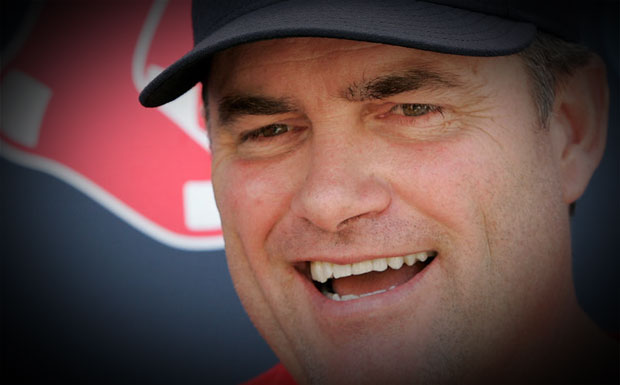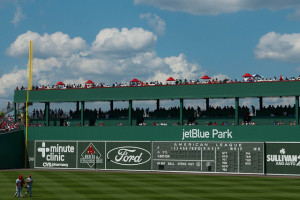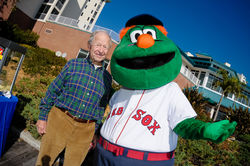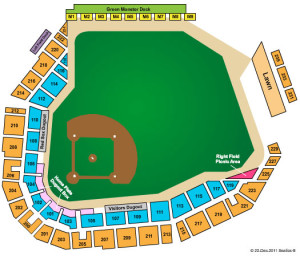 A season seemingly could not unfold worse than it did for the Boston Red Sox in 2012. Starting with spring training, new manager Bobby Valentine created tension with his coaches and players. The dysfunction grew larger like a cartoon snowball rolling down a hill as the weeks and months passed.
A season seemingly could not unfold worse than it did for the Boston Red Sox in 2012. Starting with spring training, new manager Bobby Valentine created tension with his coaches and players. The dysfunction grew larger like a cartoon snowball rolling down a hill as the weeks and months passed.
A rash of injuries to key core players didn’t help matters. Neither did subpar performances from the rotation, especially Jon Lester and Clay Buchholz (though Buchholz rebounded in the second half). The final result was a 69-93 record (which was Boston’s worst since 1965) and a last place finish in the American League East.
Given the reigns to make baseball decisions – he wasn’t responsible for hiring Valentine; Red Sox ownership was – second-year general manager Ben Cherington launched a post-season mission to restore credibility and stability to the clubhouse, rebuild the club’s culture and improve the team’s depth.
Those moves helped with the credibility, stability and culture. Cherington addressed the depth by signing free agents like first basemen Mike Napoli and Lyle Overbay, shortstop Stephen Drew, outfielders Jonny Gomes and Shane Victorino, catcher David Ross, starting pitcher Ryan Dempster and right-handed reliever Koji Uehara.
The aforementioned players are known for playing the game hard and providing a positive clubhouse presence, something that was lacking with the Red Sox in 2012.
Boston expects to contend in 2013 because of their free agent signings, the acquisition of closer Joel Hanrahan and the healthy returns of core players David Ortiz, Dustin Pedroia, Jacoby Ellsbury and Will Middlebrooks.
The Red Sox should have one of the game’s most productive lineups. Pitching is what will determine the team’s fate this year. Lester and Buchholz have the tools to serve as a formidable one-two punch atop the rotation. Boston needs All-Star caliber seasons from them to reach the playoffs. Felix Doubront, who was impressive at times as a 24-year-old left-handed rookie, and John Lackey, who is fully recovered from Tommy John surgery, give the Red Sox two more arms that have the potential to consistently shut down opposing lineups. Dempster must prove that he can navigate the tough AL lineups for an entire season.
Unlike previous seasons, Boston has intriguing starting pitching depth with Franklin Morales and Alfredo Aceves at the Major League level, and Rubby De La Rosa, Allen Webster, knuckleballer Steven Wright and underappreciated left-hander Chris Hernandez at Triple-A Pawtucket.
The Red Sox expect to boast one of baseball’s top bullpens with Hanrahan as the closer; and Morales, Aceves, Uehara, Bailey, Junichi Tazawa, Andrew Miller and Craig Breslow as set-up men. Because of their bullpen depth at the Major League and Triple-A levels, Boston will likely trade a reliever at some point before opening day.
 The Red Sox enter spring training in a position they have not seen since more than a decade ago since expectations are low in 2013. Many baseball pundits are picking Toronto to win the division, and in many prediction columns, the Red Sox join the Baltimore Orioles in the projected fight to escape the AL East basement.
The Red Sox enter spring training in a position they have not seen since more than a decade ago since expectations are low in 2013. Many baseball pundits are picking Toronto to win the division, and in many prediction columns, the Red Sox join the Baltimore Orioles in the projected fight to escape the AL East basement.
With the offseason acquisitions, combined with the return of core players and top prospects who are near Major League ready, Boston has the makings of a 2003-esque team this year (when they rebounded from a non-playoff season to reach the ALCS), so it will be a surprise if they don’t contend.
About JetBlue Park at Fenway South
 The Red Sox have trained in Ft. Myers since 1993, but last year marked the first at JetBlue Park at Fenway South. Unlike in previous seasons before JetBlue Park debuted, the Red Sox have an adjoining spring training ballpark and player development complex, which makes it more convenient for fans to monitor the Major League club and its prospects.
The Red Sox have trained in Ft. Myers since 1993, but last year marked the first at JetBlue Park at Fenway South. Unlike in previous seasons before JetBlue Park debuted, the Red Sox have an adjoining spring training ballpark and player development complex, which makes it more convenient for fans to monitor the Major League club and its prospects.
Several of the ballpark’s characteristics reflect what players will find at the actual Fenway park, including the “Green Monster” and a manually-operated scoreboard. JetBlue Park also incorporates elements of Southwest Florida such as seashells amid its brick foundation and a white roof that illustrates cypress trees in the distance.
JetBlue Park seats 11,000 (including the standing room and berm areas), six practice fields and additional facilities that house the Major League and Minor League operations along with a rehabilitation center.
About Ft. Myers
From the panhandle down to the keys, Florida boasts a plethora of unspoiled white sand beaches, exotic wildlife and lush subtropical foliage, but these characteristics are most prominently showcased by nature in Ft. Myers and its beaches and islands.
The area features a myriad of golf courses, tennis clubs and water sports activities. In fact, you can boat straight across the state of Florida from Fort Myers/Sanibel to Palm Beach via the Caloosahatchee River and Okeechobee Waterway, which are part of the Intracoastal Waterway.
Yet why venture elsewhere when there is so much to explore here? The Ft. Myers area consists of nine distinct sections. Sanibel and Captiva islands are widely known and are connected to the mainland by a three-mile-long causeway and to each other by a tiny bridge at Blind Pass.
 Sanibel Island is renowned worldwide for its shelling. More than 400 varieties of shells can be found on the beaches, especially after an especially high or low tide.
Sanibel Island is renowned worldwide for its shelling. More than 400 varieties of shells can be found on the beaches, especially after an especially high or low tide.
En route to Captiva Island, which is situated at Sanibel’s northern tip, the J.N. “Ding” Darling National Wildlife Refuge houses many exotic species of birds and plants. The refuge covers more than half the island. A four-mile drive with access to walking and canoe/kayak trails offers nature enthusiasts the chance to see alligators and long-legged wading birds.
Off the coast of Sanibel and Captiva islands, boaters can venture to 100 outer coastal islands. Many are uninhabited mangrove clusters and others are adorned with secluded beaches. North Captiva and Cayo Costa Island Preserve are known for their mostly deserted and alluring coastlines and exceptional shelling.
Built atop an ancient Calusa Indian shell mound, Cabbage Key is an island located at mile-marker 60 on the Intracoastal Waterway. Mystery writer Mary Roberts Rinehart helped her son construct his home here in 1938. It is now a cozy inn with six guest rooms and a dining room papered in thousands of autographed dollar bills. The tradition, which has generated at least $70,000 worth of signed George Washingtons, started when a thirsty fisherman left his bill taped to the wall.
Here are some must-see destinations when visiting the Ft. Myers area:
Located on Sanibel Island, the Bailey-Matthews Shell Museum is the most comprehensive museum in the Western Hemisphere devoted solely to shells. More than 30 exhibits detail shells in art and history, shell habitats, rare specimens, fossil shells, and common southwest Florida shells. The children’s learning lab contains a hands-on play area and a “live tank” with indigenous mollusks.
Also situated on Sanibel Island is the J.N. “Ding” Darling National Wildlife Refuge. A 6,400-acre wildlife refuge, named for Pulitzer Prize-winning cartoonist and pioneer environmentalist Jay Norwood Darling, has bird watching spots, footpaths, winding canoe trails and three trails that can be accessed from Wildlife Drive.
The four mile, round-trip Indigo Trail leaves from the Education Center parking lot and ends at the cross-dike, which extends from Wildlife Drive. Along the trail, visitors often spot wildlife such as alligators, night heron and white ibis. The Wulfert Keys Trail is a 1/4 mile trail leading to a view of Pine Island Sound. The Shell Mound Trail is a 1/4 mile interpretive boardwalk where visitors learn about the ancient Calusa Indian tribe and the native vegetation while reading interpretive panels along the boardwalk.
 On the nature-rich Captiva Island, Captiva Cruises provides guests with a memorable island-hopping tour with access to Cabbage Key, Useppa Island, Cayo Costa and Boca Grande. Daily lunch cruises to Cabbage Key and Useppa Island are made aboard the 150-passenger “Lady Chadwick.”
On the nature-rich Captiva Island, Captiva Cruises provides guests with a memorable island-hopping tour with access to Cabbage Key, Useppa Island, Cayo Costa and Boca Grande. Daily lunch cruises to Cabbage Key and Useppa Island are made aboard the 150-passenger “Lady Chadwick.”
Located at mile marker 60 on the Intracoastal Waterway, Cabbage Key has a marina, historic inn, picturesque dining room, water tower view of Pine Island Sound and nature trails. Useppa Island, which operates as a private club, relives the glamour and history of a bygone era with pink pathways, lush vegetation, authentic “old Florida” architecture and the Collier Inn restaurant, as well as an island museum.
Also on Captiva Island, Captiva Kayak Company & Wildside Adventures embarks on excursions to bays, beaches and bayous on Back Bay and ecological tours to Buck Key.
In Ft. Myers, The Butterfly Estates is a new attractions located in the River District downtown. Guests are surrounded with thousands of butterflies at this botanical garden and butterfly habitat with cascading waterfalls and lush tropical nectar plants.
Of course, the centerpieces of Ft. Myers are the Edison & Ford Winter Estates.
For 15 miles, Fort Myers’ McGregor Boulevard is lined on both sides with statuesque royal palm trees, the first 200 of which were imported from Cuba and planted by Edison.
Edison, who spent many winters in Fort Myers, is considered the most inventive man who ever lived, holding 1,093 patents for everything from light bulbs, cement and phonographs to the natural rubber he made from goldenrod.
Edison’s 14- acre riverfront estate is steeped in history. The inventor’s “old-Florida” style home, laboratory and experimental gardens have been authentically maintained. With 225,000 guests each year, it is one of the most visited national Historic Homes in the country. The Estates include nine National Register Historic buildings along with the botanical and research gardens.
Rare antique automobiles and Edison phonographs are among the carefully preserved artifacts. His gardens are a wonderland of rare and exotic tropical vegetation, including a banyan tree that was a gift from Harvey Firestone in 1925. It is now the largest banyan tree in the continental U.S.
The laboratory is where Edison turned goldenrod to rubber. The home and guesthouse, built in 1886, are on the National Register of Historic Places. They were deeded to the City of Fort Myers in 1947 by Edison’s widow, Mina Miller Edison, and opened to the public that same year.
After exploring the Edison Home, visitors can walk next door to the winter home of automobile industrialist Henry Ford. Ford purchased the 3 1/2-acre estate in 1916 to spend the winter months visiting his friend Edison. Ford’s home, “Mangoes,” has undergone extensive renovation to bring it back to the period when he and his wife Clara lived there. A 1914 Model T, 1919 Model T, 1917 Ford Truck, and 1929 Model A also are on display.

Boston Red Sox Spring Training Information
First Practice Dates
Pitchers and Catchers
February 12
Position Players
February 15
Jet Blue Park
11500 Fenway South Drive
Fort Myers, FL 33913
Ticket Information: (888) RED-SOX6 (733-7696) and (239) 334-4700 (JetBlue Park box office)
2013 Ticket Prices
 Home Plate Dugout Box, $46
Home Plate Dugout Box, $46
Green Monster Seats, $35
Home Plate Box, $32
Field Box, $30
Left Field and Right Field Box, $27
Grandstand, $27
Green Monster Deck Seats, $25
Left Field and Right Field Grandstand, $25
Left Field Deck Seats, $15
Green Monster SRO, $15
Bleacher Seats $10
Right Field Picnic Area, $10
Left Field Deck SRO, $10
Reserved Lawn, $5
For More Information About Ft. Myers:
Lee County Visitors & Convention Bureau, (239) 338-3500, www.FortMyersSanibel.com
